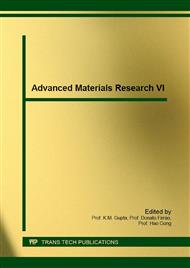p.23
p.29
p.37
p.43
p.48
p.55
p.63
p.68
p.73
Effect of the SF6 Flow Injection Time on the Formation of the Carbon Coils
Abstract:
Carbon coils could be synthesized using C2H2/H2 as source gases and SF6 as an incorporated additive gas under thermal chemical vapor deposition system. Bunch-type large-sized (100 ~ 200 μm in diameter) Ni grains were used as the catalyst for the formation of the carbon coils. According to the different reaction processes, the injection time of SF6 gas flow was varied from 1.0 min to 60 min. The characteristics (formation density, morphology, and geometry) of the deposited carbon coils on the substrates were investigated according to the different reaction processes. Finally, both the high production yield of carbon coils and their geometry control could be achieved merely by manipulating SF6 gas flow injection time. Two cases growth patterns were proposed according to SF6 gas flow injection time in association with the fluorine’s characteristics for etching the materials or enhancing the nucleation sites.
Info:
Periodical:
Pages:
48-54
Citation:
Online since:
April 2016
Authors:
Price:
Сopyright:
© 2016 Trans Tech Publications Ltd. All Rights Reserved
Share:
Citation:


